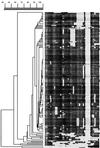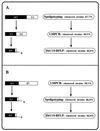Comparative evaluation of ligation-mediated PCR and spoligotyping as screening methods for genotyping of Mycobacterium tuberculosis strains
- PMID: 10488164
- PMCID: PMC85507
- DOI: 10.1128/JCM.37.10.3118-3123.1999
Comparative evaluation of ligation-mediated PCR and spoligotyping as screening methods for genotyping of Mycobacterium tuberculosis strains
Abstract
Spoligotyping has been suggested as a screening test in multistep genotyping of Mycobacterium tuberculosis strains. Relying on restriction fragment length polymorphism (RFLP) analysis with IS6110 (IS6110 RFLP analysis) as a "gold standard," we performed a comparative evaluation of spoligotyping and ligation-mediated PCR (LMPCR), a recently described PCR-based typing method, as rapid screening tests for fingerprinting of 158 M. tuberculosis strains collected in Verona, Italy. LMPCR seemed to be comparable to spoligotyping in terms both of feasibility with rapidly extracted DNA and of generation of software-analyzable images. Moreover, LMPCR grouped considerably fewer strains than spoligotyping (38 versus 67%) and was found to reduce the cluster overestimation rate (26.3 versus 58%) and to give a better discriminatory index (0.992 versus 0.970) compared to spoligotyping. In our geographical region, where there was no evidence of clustered strains carrying fewer than six IS6110 copies, LMPCR was found to be more discriminatory than spoligotyping. We also evaluated two models of three-step typing strategies, involving the use of spoligotyping and LMPCR as screening methods and IS6110 RFLP analysis as a further supporting test. LMPCR proved to be a more effective first-step test than spoligotyping, significantly reducing the need for subtyping. LMPCR should be considered an alternative to spoligotyping as a rapid screening method for M. tuberculosis fingerprinting, particularly in areas with a low prevalence of M. tuberculosis strains carrying few copies of IS6110.
Figures




Similar articles
-
Genetic diversity of Mycobacterium tuberculosis in Sicily based on spoligotyping and variable number of tandem DNA repeats and comparison with a spoligotyping database for population-based analysis.J Clin Microbiol. 2001 Apr;39(4):1559-65. doi: 10.1128/JCM.39.4.1559-1565.2001. J Clin Microbiol. 2001. PMID: 11283087 Free PMC article.
-
[The identification of Mycobacterium tuberculosis isolates by DNA typing technique].Zhonghua Liu Xing Bing Xue Za Zhi. 2005 May;26(5):361-5. Zhonghua Liu Xing Bing Xue Za Zhi. 2005. PMID: 16053765 Chinese.
-
Genotyping Mycobacterium tuberculosis isolates with few copies of IS6110: Value of additional genetic markers.Infect Genet Evol. 2020 Jul;81:104230. doi: 10.1016/j.meegid.2020.104230. Epub 2020 Feb 6. Infect Genet Evol. 2020. PMID: 32035976
-
Usefulness of spoligotyping To discriminate IS6110 low-copy-number Mycobacterium tuberculosis complex strains cultured in Denmark.J Clin Microbiol. 1999 Aug;37(8):2602-6. doi: 10.1128/JCM.37.8.2602-2606.1999. J Clin Microbiol. 1999. PMID: 10405409 Free PMC article.
-
Spoligotyping followed by double-repetitive-element PCR as rapid alternative to IS6110 fingerprinting for epidemiological studies of tuberculosis.J Clin Microbiol. 1998 Apr;36(4):1122-4. doi: 10.1128/JCM.36.4.1122-1124.1998. J Clin Microbiol. 1998. PMID: 9542951 Free PMC article.
Cited by
-
Genetic diversity of Mycobacterium tuberculosis in Sicily based on spoligotyping and variable number of tandem DNA repeats and comparison with a spoligotyping database for population-based analysis.J Clin Microbiol. 2001 Apr;39(4):1559-65. doi: 10.1128/JCM.39.4.1559-1565.2001. J Clin Microbiol. 2001. PMID: 11283087 Free PMC article.
-
Current methods in the molecular typing of Mycobacterium tuberculosis and other mycobacteria.Biomed Res Int. 2014;2014:645802. doi: 10.1155/2014/645802. Epub 2014 Jan 5. Biomed Res Int. 2014. PMID: 24527454 Free PMC article. Review.
-
Genetic biodiversity of Mycobacterium tuberculosis complex strains from patients with pulmonary tuberculosis in Cameroon.J Clin Microbiol. 2003 Jun;41(6):2547-53. doi: 10.1128/JCM.41.6.2547-2553.2003. J Clin Microbiol. 2003. PMID: 12791879 Free PMC article.
-
Beijing/W genotype Mycobacterium tuberculosis and drug resistance.Emerg Infect Dis. 2006 May;12(5):736-43. doi: 10.3201/eid1205.050400. Emerg Infect Dis. 2006. PMID: 16704829 Free PMC article.
-
Spoligotype database of Mycobacterium tuberculosis: biogeographic distribution of shared types and epidemiologic and phylogenetic perspectives.Emerg Infect Dis. 2001 May-Jun;7(3):390-6. doi: 10.3201/eid0703.010304. Emerg Infect Dis. 2001. PMID: 11384514 Free PMC article.
References
-
- Díaz R, Kremer K, de Haas P E W, Gómez R I, Marrero A, Valdivia J A, van Embden J D A, van Soolingen D. Molecular epidemiology of tuberculosis in Cuba outside of Havana, July 1994–June 1995: utility of spoligotyping versus IS6110 restriction fragment length polymorphism. Int J Tuberc Lung Dis. 1998;2:743–750. - PubMed
-
- Gutiérrez M C, Vincent V, Aubert D, Bizet J, Gaillot O, Lebrun L, Le Pendeven C, Le Pennec M P, Mathieu D, Offredo C, Pangon B, Pierre-Audigier C. Molecular fingerprinting of Mycobacterium tuberculosis and risk factors for tuberculosis transmission in Paris, France, and surrounding area. J Clin Microbiol. 1998;36:486–492. - PMC - PubMed
Publication types
MeSH terms
Substances
LinkOut - more resources
Full Text Sources

